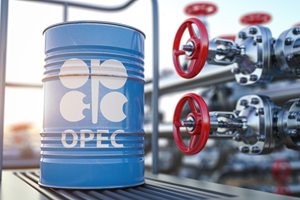OPEC-watchers expect steady output as oil outlook tightens
(Bloomberg) — OPEC+ is expected to keep output steady when it meets next week, anticipating that oil markets will recover from a recent price rout and tighten by year-end.
Group leader Saudi Arabia floated the option of a production cut last week in order to stabilize crude-futures markets, and received enthusiastic backing from other members. Oil prices have suffered their longest run of losses since 2020 on fears over the strength of the global economy, imperiling the unprecedented windfall that OPEC+ nations are enjoying this year.
Nonetheless, traders and analysts surveyed by Bloomberg expect that the Organization of Petroleum Exporting Countries and its allies will hold production steady at Monday’s gathering. World markets are on track to heal as China’s emergence from the Covid-19 pandemic -- despite some setbacks -- boosts demand, while sanctions on Russia curtail supplies, they said.
“I expect OPEC will keep production quotas unchanged -- the market is tight,” said Daniel Hynes, an analyst at Australia & New Zealand Banking Group Ltd. “However, if rhetoric doesn’t stem the selling in crude oil, they may be forced” to take a stronger stance later on, he said.
Fifteen of 19 respondents predicted that OPEC+ will decide to keep October production levels unchanged, while the others forecast a cut. Delegates from the producers’ alliance privately said the 23-nation bloc is still weighing its options as members grapple with an uncertain outlook. The outcome of meetings has often surprised observers in recent years.
Rising Demand
OPEC’s newly-appointed Secretary-General, Haitham Al Ghais, said last month that he expects a “bullish” surge of demand from consumers eager to resume normalcy after two-years of Covid restrictions. An OPEC+ committee that met on Wednesday revised its forecasts to show a supply shortfall in the fourth quarter.
While supplies from OPEC+ nation Russia have so far proven surprisingly resilient following the invasion of Ukraine, they are expected to falter over the new few months with the onset of European Union sanctions in early December.
The group is also waiting to see whether fellow-member Iran will finally clinch a nuclear accord that would remove US sanctions on its oil sales. If there is a deal, it could give the green light to a flood of extra crude onto world markets.
Negotiations appeared be gaining momentum in recent weeks, only to cool down again. French President Emmanuel Macron said on Thursday that he hoped the negotiations would be concluded soon.
“There will have to be more clarity on Iran before OPEC+ decides on anything,” said Amrita Sen, chief oil analyst at consultants Energy Aspects Ltd. “Right now we would say they can just hold production flat.”
Cutting production could in any case be a politically move sensitive for OPEC+.
The alliance has only just finished reversing the massive supply curbs made at the outset of the Covid-19 pandemic, and consuming nations are urging the group to help tame fuel costs and rampant inflation by keeping the taps open.
Despite strong calls from US President Joe Biden for additional supplies during a milestone trip to Saudi Arabia in July, OPEC+ responded at its last gathering by pledging a token increase of just 100,000 barrels a day for September, insisting it had to ration its remaining spare production capacity with great caution.
To follow such a negligible rise with a cutback could undermine the kingdom’s critical, and sometimes fraught, relationship with Washington.
“It would be odd to cut output whilst their numbers are showing a tighter-than-expected market,” said Warren Patterson, head of commodities strategy at ING Groep NV in Singapore.



